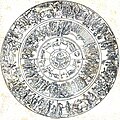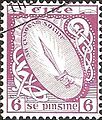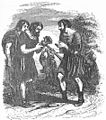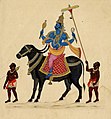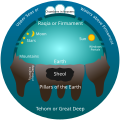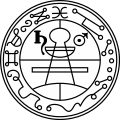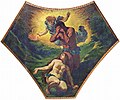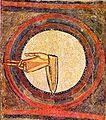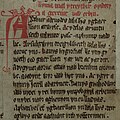The Myths Portal

Myth is a genre of folklore or theology consisting primarily of narratives that play a fundamental role in a society, such as foundational tales or origin myths. For folklorists, historians, philosophers or theologians this is very different from the use of "myth" simply indicating that something is not true. Instead, the truth value of a myth is not a defining criterion.
Myths are often endorsed by secular and religious authorities and are closely linked to religion or spirituality. Many societies group their myths, legends, and history together, considering myths and legends to be true accounts of their remote past. In particular, creation myths take place in a primordial age when the world had not achieved its later form. Other myths explain how a society's customs, institutions, and taboos were established and sanctified. There is a complex relationship between recital of myths and the enactment of rituals. (Full article...)
Selected article -

In Norse mythology, a valkyrie (from Old Norse: valkyrja, lit. 'chooser of the slain') is one of a host of female figures who guide souls of the dead to the god Odin's hall Valhalla. There, the deceased warriors become einherjar (Old Norse "single (or once) fighters"). When the einherjar are not preparing for the cataclysmic events of Ragnarök, the valkyries bear them mead. Valkyries also appear as lovers of heroes and other mortals, where they are sometimes described as the daughters of royalty, sometimes accompanied by ravens and sometimes connected to swans or horses.
Valkyries are attested in the Poetic Edda (a book of poems compiled in the 13th century from earlier traditional sources), the Prose Edda, the Heimskringla (both by Snorri Sturluson) and the Njáls saga (one of the Sagas of Icelanders), all written—or compiled—in the 13th century. They appear throughout the poetry of skalds, in a 14th-century charm, and in various runic inscriptions. (Full article...)Did you know? -
- ...that the Tigmamanukan, a Philippine mythological bird, can be a good or bad omen depending on the direction of its flight?
- ...that the most popular deity worshipped by the Duala peoples of Cameroon is a mermaid called a jengu?
- ... that the origin of the Postclassic K'iche' Maya patron deity Jacawitz has been traced back to a historical event at the city of Seibal?
- ...that Apaliunas, a Luwian deity of Wilusa (Troy) attested among gods in a treaty inscription, ca. 1280 BCE, is a likely precursor of Apollo of Greek mythology?
Recognised content
Featured Articles: ![]() Ahalya,
Ahalya, ![]() Ancient Egyptian literature,
Ancient Egyptian literature, ![]() King Arthur,
King Arthur, ![]() Ganesha,
Ganesha, ![]() Iravan,
Iravan, ![]() Orion (mythology),
Orion (mythology), ![]() Vampire,
Vampire, ![]() Vithoba
Vithoba
Featured Lists: ![]() List of valkyrie names in Norse mythology
List of valkyrie names in Norse mythology
Good Articles: ![]() 2012 phenomenon,
2012 phenomenon, ![]() Æsir–Vanir War,
Æsir–Vanir War, ![]() Ala (demon),
Ala (demon), ![]() Anu,
Anu, ![]() Aphrodite,
Aphrodite, ![]() Athena,
Athena, ![]() Ardhanarishvara,
Ardhanarishvara, ![]() Battle of Barry,
Battle of Barry, ![]() Bhikshatana,
Bhikshatana, ![]() Catalogue of Women,
Catalogue of Women, ![]() Chamunda,
Chamunda, ![]() Chhinnamasta,
Chhinnamasta, ![]() Consorts of Ganesha,
Consorts of Ganesha, ![]() Cú Chulainn,
Cú Chulainn, ![]() Dhumavati,
Dhumavati, ![]() Dumuzid,
Dumuzid, ![]() Einherjar,
Einherjar, ![]() Eir,
Eir, ![]() Enlil,
Enlil, ![]() Fairy Flag,
Fairy Flag, ![]() Fenrir,
Fenrir, ![]() Gerðr,
Gerðr, ![]() Hel (being),
Hel (being), ![]() Huginn and Muninn,
Huginn and Muninn, ![]() Iðunn,
Iðunn, ![]() Ila (Hinduism),
Ila (Hinduism), ![]() Inanna,
Inanna, ![]() Kabandha,
Kabandha, ![]() Kali,
Kali, ![]() Kamadhenu,
Kamadhenu, ![]() Kangiten,
Kangiten, ![]() Keshi (demon),
Keshi (demon), ![]() Khandoba,
Khandoba, ![]() Kratos (mythology)
Kratos (mythology) ![]() Krishna,
Krishna, ![]() Kubera,
Kubera, ![]() LGBT themes in Hindu mythology,
LGBT themes in Hindu mythology, ![]() Manasa,
Manasa, ![]() Mandodari,
Mandodari, ![]() Matangi,
Matangi, ![]() Matrikas,
Matrikas, ![]() Maya Sita,
Maya Sita, ![]() Mohini,
Mohini, ![]() Myrrha,
Myrrha, ![]() Mythology of Carnivàle,
Mythology of Carnivàle, ![]() Naraka (Hinduism),
Naraka (Hinduism), ![]() Ninurta,
Ninurta, ![]() Prester John,
Prester John, ![]() Prithu,
Prithu, ![]() Putana,
Putana, ![]() Rati,
Rati, ![]() Ratatoskr,
Ratatoskr, ![]() Revanta,
Revanta, ![]() Satyavati,
Satyavati, ![]() Satyr,
Satyr, ![]() Sharabha,
Sharabha, ![]() Shashthi,
Shashthi, ![]() Shiva,
Shiva, ![]() Sif,
Sif, ![]() Tara (Ramayana),
Tara (Ramayana), ![]() Troilus,
Troilus, ![]() Tuisto,
Tuisto, ![]() Valhalla,
Valhalla, ![]() Valkyrie,
Valkyrie, ![]() Vampire folklore by region,
Vampire folklore by region, ![]() Varaha,
Varaha, ![]() Varahi,
Varahi, ![]() Veðrfölnir and eagle
Veðrfölnir and eagle ![]() Zduhać
Zduhać
Wikiversity
Selected creature -

The boobrie is a mythological shapeshifting entity inhabiting the lochs of the west coast of Scotland. It commonly adopts the appearance of a gigantic water bird resembling a cormorant or great northern diver, but it can also materialise in the form of various other mythological creatures such as a water bull.
A generally malevolent entity, the boobrie typically preys on livestock being transported on ships, but it is also fond of otters, of which it consumes a considerable number. In its manifestation as a water horse the creature is able to gallop across the top of lochs as if on solid ground. During the summer months it is seen infrequently as a large insect, sucking the blood of horses. (Full article...)General images
Subcategories
WikiProjects
Things you can do
- Help with the myth and folklore missing articles project.
- Help create requested articles.
- Help assessment at Wikipedia:WikiProject Mythology/Assessment.
- Place the project banner {{WikiProject Mythology}} on the talk pages of all relevant articles.
- Check the recent changes for recent improvements, vandalism, and other changes.
- Answer requests for mythology articles needing attention: Category:Mythology articles needing attention
- Answer requests for mythology articles needing expert attention: Category:Mythology articles needing expert attention
- Expand articles tagged as mythology stubs: Category:Mythology stubs
- Assist mythology subprojects.
- Add requested photographs of mythology subjects: Category:Wikipedia requested photographs of mythology subjects
Associated Wikimedia
The following Wikimedia Foundation sister projects provide more on this subject:
- Commons
Free media repository - Wikibooks
Free textbooks and manuals - Wikidata
Free knowledge base - Wikinews
Free-content news - Wikiquote
Collection of quotations - Wikisource
Free-content library - Wikiversity
Free learning tools - Wiktionary
Dictionary and thesaurus






